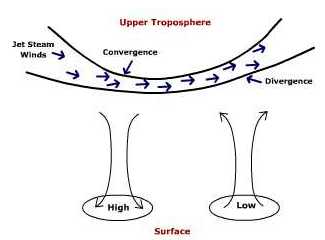Surface Cyclones and the Jet StreamAbove the polar front lies the polar front jet stream, a zone of faster moving air in the upper troposphere. The jet stream takes on a meandering pattern with regions of faster and slower air. Within the jet stream there are regions air convergence and divergence.
Recall that surface air converges and rises in low pressure systems. To maintain low pressure at the surface the rising air must diverge at the top. It is this upper air divergence in the jet stream that "pulls" air upward to help form surface cyclones. In so doing, surface cyclones tend to follow the path of the jet stream. Figure 8.14 shows the relationship between upper-level flow and surface pressure systems. We can see that where upper level convergence occurs air sinks to promote high pressure at the surface. Where upper-level divergence occurs air is pulled up from the surface to help create low pressure near the ground. Wave cyclones dissolve when they no longer have the upper level divergence to maintain them. |

